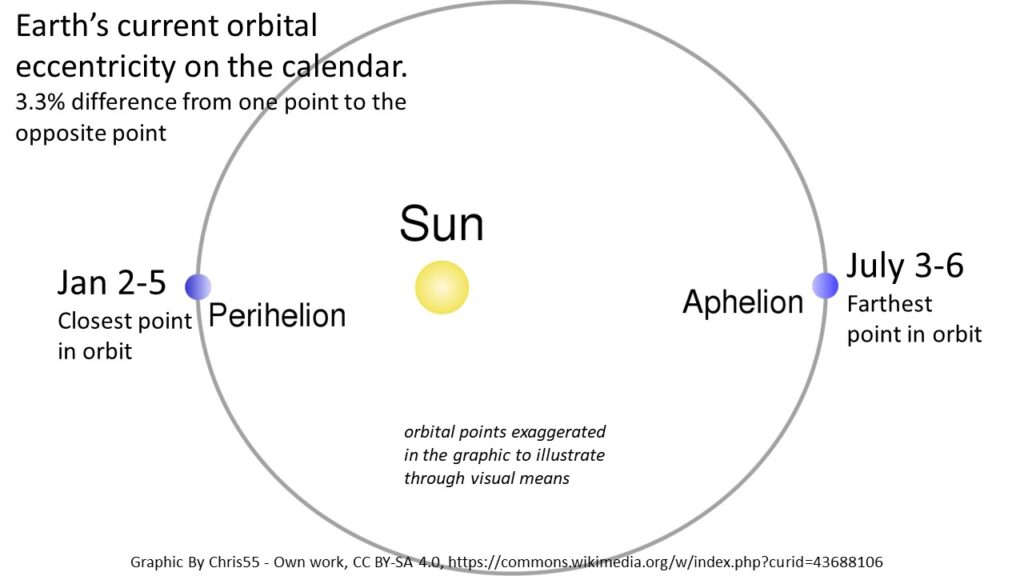The Earth’s orbit is not a perfect circle. There is one day where it reaches its closest point to the Sun and a day at its farthest point. Perihelion is when our blue jewel of a planet comes to its nearest point and that day happens in early January each year (currently). The disk of the Sun is slightly larger at this time while slightly smaller in July. It will happen at 9am PST / 12pm EST with the Sun at 14°03’ Capricorn in the Archer constellation and not far from its zodiacal opposition with the star Sirius (14°23’ Cancer).
Perihelion is upon us as Earth will be only .9833 AU (Astronomical Unit) from the Sun (with 1 AU about 93 million miles, the average distance between the Earth and Sun). This translates to the Earth being only 91.4 million miles from the Sun or over 1 ½ million miles closer to the Sun on January 4th. On the opposite end of Earth’s orbit is its aphelion (farthest point from the Sun) at 94.5 million miles from the Sun, which takes place in early July each year at this current time (July 6 this year). From one extreme to the other, it is about 3.3% difference. Comparatively, Pluto is as much as a 40% difference and Eris at 60% difference.

Since the Northern Hemisphere is pointed away from the Sun in January, the effects of the closer pass with the Sun are not felt all that much. But the Southern Hemisphere experiences a little more sunshine and heat from the Sun in January. However, the summers in the Northern Hemisphere are hotter than those in the Southern Hemisphere due to the abundance of land masses in the North when compared to the South.
The aphelion and perihelion dates can change each year due to the Moon’s gravitational effect on the Earth. For the perihelion, this means that the closest point can very anywhere from January 2nd to the 5th. This also applies to the aphelion as well, so while the closest and farthest points in the Earth’s orbit can vary by a few days, one can count on it being roughly six months apart in early January and July.
Whenever a planet’s orbit is closer in to the Sun, that planet moves faster with Earth being no exception to that fact. While it may seem at times that the winters can be long and summers short, the opposite is the reality. The Earth is now moving at a slightly faster rate now, meaning from the September equinox to the March equinox is only 179 days (rounded up), on average. While from the March equinox to the September equinox is 186 days (rounded down), on average, meaning the Northern winter is only 89 days while the Northern summer is 4 ½ days longer.
There is a larger rhythm of Earth’s orbit, which can change slowly over thousands of years. Currently, Earth’s orbit is currently becoming less eccentric and more circular. In tens of thousands of years, it will then become less circular. It takes approximately 100,000 years to complete the cycle (orbital eccentricity) of this orbital rhythm, but there are other factors in a wider rhythm of over 400,000 years. But there are other cycles within these and some even longer, so the 100k and 400k cycles are only part of the story.
Knowing the closest and farthest points of the Earth’s orbit is important to astrology as well. Earth has various movements, which we can collectively call its sacred movements. Aling with the Earth’s spin, wobble, and tilt, it includes the orbit of the Earth around the Sun. The closest point is in the season of Capricorn, archetypally representing the teacher, planner and wisdom carrier. The Earth herself is picking up more wisdom and understanding being closer to the Sun. It is how humanity has oriented itself, navigated and track the passage of linear time.
And the celestial movements of the Earth, Sun, Moon, planets and more is how astrology was formed in the first place. We can take a moment to connect into this great rhythm of the Earth relative to the Sun and other planets and meditate on what this means to be closer to powerful source of light and life.